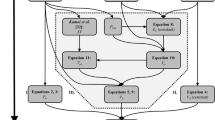Abstract
The end-systolic elastance (\(E_{\text {es}}\)) – the slope of the end-systolic pressure-volume relationship (ESPVR) at the end of ejection phase – has become a reliable indicator of myocardial functional state. The estimation of \(E_{\text {es}}\) by the original multiple-beat method is invasive, which limits its routine usage. By contrast, non-invasive single-beat estimation methods, based on the assumption of the linearity of ESPVR and the uniqueness of the normalised time-varying elastance curve \(E^N(t)\) across subjects and physiology states, have been applied in a number of clinical studies. It is however known that these two assumptions have a limited validity, as ESPVR can be approximated by a linear function only locally, and \(E^N(t)\) obtained from a multi-subject experiment includes a confidence interval around the mean function. Using datasets of 3 patients undergoing general anaesthesia (each containing aortic flow and pressure measurements at baseline and after introducing a vasopressor noradrenaline), we first study the sensitivity of two single-beat methods—by Sensaki et al. and by Chen et al.—to the uncertainty of \(E^N(t)\). Then, we propose a minimally-invasive method based on a patient-specific biophysical modelling to estimate the whole time-varying elastance curve \(E^{\text {model}}(t)\). We compare \(E^{\text {model}}_{\text {es}}\) with the two single-beat estimation methods, and the normalised varying elastance curve \(E^{N,\text {model}}(t)\) with \(E^{N}(t)\) from published physiological experiments.
Access this chapter
Tax calculation will be finalised at checkout
Purchases are for personal use only
Similar content being viewed by others
References
Burkhoff, D.: Assessment of systolic and diastolic ventricular properties via pressure-volume analysis: a guide for clinical, translational, and basic researchers. AJP: Heart Circulatory Physiol. 289(2), H501–H512 (2005)
Caruel, M., Chabiniok, R., Moireau, P., Lecarpentier, Y., Chapelle, D.: Dimensional reductions of a cardiac model for effective validation and calibration. Biomech. Model. Mechanobiol. 13(4), 897–914 (2014)
Chabiniok, R., Moireau, P., Kiesewetter, C., Hussain, T., Razavi, R., Chapelle, D.: Assessment of atrioventricular valve regurgitation using biomechanical cardiac modeling. In: Pop, M., Wright, G.A. (eds.) FIMH 2017. LNCS, vol. 10263, pp. 401–411. Springer, Cham (2017). https://doi.org/10.1007/978-3-319-59448-4_38
Chapelle, D., Le Tallec, P., Moireau, P., Sorine, M.: Energy-preserving muscle tissue model: formulation and compatible discretizations. Int. J. Multiscale Comput. Eng. 10(2), 189–211 (2012)
Chen, C.H., et al.: Noninvasive single-beat determination of LV end-systolic elastance in humans. JACC 38(7), 2028–2034 (2001)
Gaddum, N., Alastruey, J., Chowienczyk, P., Rutten, M.C., Segers, P., Schaeffter, T.: Relative contributions from the ventricle and arterial tree to arterial pressure and its amplification: an experimental study. Am. J. Physiol. Heart Circulatory Physiol. 313(3), H558–H567 (2017)
Gayat, E., Mor-Avi, V., Weinert, L., Yodwut, C., Lang, R.M.: Noninvasive quantification of LV elastance and ventricular-arterial coupling using 3D echo and arterial tonometry. AJP: Heart Circulatory Physiol. 301(5), H1916–H1923 (2011)
Holzapfel, G.A., Ogden, R.W.: Constitutive modelling of passive myocardium: a structurally based framework for material characterization. Phil. Trans. R. Soc. A: Math. Phys. Eng. Sci. 367(1902), 3445–3475 (2009)
Huxley, A.F.: Muscular contraction. J. Physiol. 243(1), 1–43 (1974)
Joachim, J., et al.: Velocity-pressure loops for continuous assessment of ventricular afterload: influence of pressure measurement site. J. Clin. Monit. Comput. 32(5), 833–840 (2017)
Klotz, S., et al.: Single-beat estimation of end-diastolic pressure-volume relationship: a novel method with potential for noninvasive application. AJP: Heart Circulatory Physiol. 291(1), H403–H412 (2006)
Ruijsink, B., Zugaj, K., Pushparajah, K., Chabiniok, R.: Model-based indices of early-stage cardiovascular failure and its therapeutic management in Fontan patients. In: Coudière, Y., et al. (eds.) FIMH 2019. LNCS, vol. 11504, pp. 379–387. Springer, Cham (2019)
Sagawa, K., Maughan, L., Suga, H., Sunagawa, K.: Cardiac Contraction and the Pressure Volume Relationship. Oxford University Press, New York (1988)
Senzaki, H., Chen, C.H., Kass, D.A.: Single-beat estimation of end-systolic pressure-volume relation in humans: a new method with the potential for noninvasive application. Circulation 94(10), 2497–2506 (1996)
Shishido, T., Hayashi, K., Shigemi, K., Sato, T., Sugimachi, M., Sunagawa, K.: Single-beat estimation of end-systolic elastance using bilinearly approximated time-varying elastance curve. Circulation 102(16), 1983–1989 (2000)
Suga, H., Sagawa, K., Shoukas, A.A.: Load independence of the instantaneous pressure-volume ratio of the canine left ventricle and effects of epinephrine and heart rate on the ratio. Circulation Res. 32(3), 314–322 (1973)
Acknowledgment
We acknowledge Prof. Alexandre Mebazaa, and Prof. Etienne Gayat (Anaesthesiology and Intensive Care department, Lariboisière hospital, Paris, France) for their support in conducting the study. In addition, we would like to acknowledge Dr. Philippe Moireau, Inria research team M\(\mathsf {\** }\)DISIM, for the development of the cardiac simulation software CardiacLab used in this work.
Author information
Authors and Affiliations
Corresponding author
Editor information
Editors and Affiliations
Rights and permissions
Copyright information
© 2019 Springer Nature Switzerland AG
About this paper
Cite this paper
Le Gall, A., Vallée, F., Chapelle, D., Chabiniok, R. (2019). Minimally-Invasive Estimation of Patient-Specific End-Systolic Elastance Using a Biomechanical Heart Model. In: Coudière, Y., Ozenne, V., Vigmond, E., Zemzemi, N. (eds) Functional Imaging and Modeling of the Heart. FIMH 2019. Lecture Notes in Computer Science(), vol 11504. Springer, Cham. https://doi.org/10.1007/978-3-030-21949-9_29
Download citation
DOI: https://doi.org/10.1007/978-3-030-21949-9_29
Published:
Publisher Name: Springer, Cham
Print ISBN: 978-3-030-21948-2
Online ISBN: 978-3-030-21949-9
eBook Packages: Computer ScienceComputer Science (R0)




